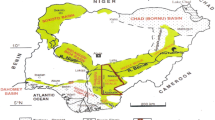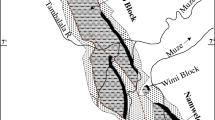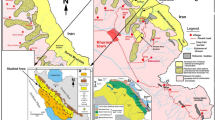Abstract
The presence of anomalous terrestrial radioisotopes must be suspected in black shale-hosted manganese ore deposits, based on high organic matter content, which is useful tool in genetic, among them paleoenvironmental investigations. Our work aims at the characterization of the paleoredox conditions of the Úrkút Manganese Formation based on comparison of terrestrial radioisotopes and selected element ratios. Paleoredox indicators were estimated on U/Th, δU, Ni/Co, V/Cr, V/(V + Ni) and Ce*. The results of paleoredox indicator element ratios show, that these methods must be used with caution (microbial selective element enrichments, mobilizations), and the complex interpretation using mineralogy and microtexture can be recommended.


Similar content being viewed by others
References
Polgári M, Hein JR, Fórizs I, Vigh T, Szabó-Drubina M, Bíró L, Müller A, Tóth AL (2012) Microbial processes and the origin of the Úrkút manganese deposit, Hungary. Ore Geol Rev 47:87–109
Vigh T, Kovács T, Somlai J, Kávási N, Polgári M, Bíró L (2013) Terrestrial radioisotopes in black shale hosted Mn-carbonate deposit (Úrkút, Hungary). Acta Geophys 61(4):831–847
Polgári M, Hein JR, Tóth AL, Pál-Molnár E, Vigh T, Bíró L, Fintor K (2012) Microbial action formed Jurassic Mn-carbonate ore deposit in only few hundred years (Úrkút, Hungary). Geology 40(10):903–906
Wignall PB, Myers KJ (1988) Interpreting the benthic oxygen levels in mudrocks: a new approach. Geology 16:452–455
Rimmer S (2004) Geochemical paleoredox indicators in Devonian-Mississippian black shales, Central Appalachian Basin (USA). Chem Geol 206:373–391
Yang B, Hu B, Bao Z, Zhang Z (2011) REE geochemical characteristics and depositional environment of the black shale-hosted Baiguoyuan Ag-V deposit in Xingshan, Hubei Province, China. J Rare Earths 29(5):499–506
Jeans CV, Wray DS, Merriman RJ, Fisher MJ (2000) Volcanogenic clays in Jurassic and Cretaceous strata of England and the North Sea Basin. Clay Miner 35:25–55
Macchour L, Philip J, Oudin JL (1994) Formation of laminite deposits in anaerobic-dysaerobic marine environments. Mar Geol 117:287–302
Wedepohl KH (1971) Environmental influences on the chemical composition of shales and clays. In: Press F, Runcorn SK, Urey HC, Ahrens LH (eds) Physics and chemistry of the earth. Pergamon, Oxford
Polgári M, Hein JR, Németh T, Pál-Molnár E, Vigh T (2013) Celadonite and smectite formation in the Úrkút Mn-carbonate ore deposit (Hungary). Sediment Geol 294:157–163
Acknowledgments
Lóránt Bíró's research was supported by the European Union and the State of Hungary, co-financed by the European Social Fund in the framework of TÁMOP 4.2.4. A/2-11-1-2012-0001 ‘National Excellence Program’.
Author information
Authors and Affiliations
Corresponding author
Rights and permissions
About this article
Cite this article
Bíró, L., Polgári, M., M. Tóth, T. et al. Terrestrial radioisotopes as paleoenvironmental proxies in sedimentary formations. J Radioanal Nucl Chem 306, 289–293 (2015). https://doi.org/10.1007/s10967-014-3861-z
Received:
Published:
Issue Date:
DOI: https://doi.org/10.1007/s10967-014-3861-z




